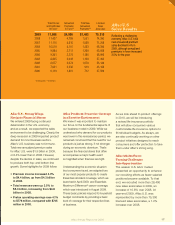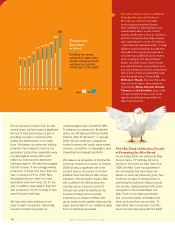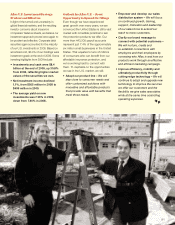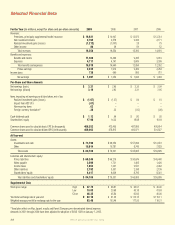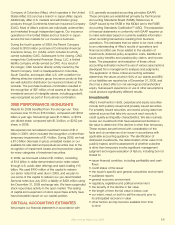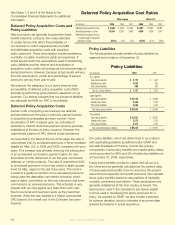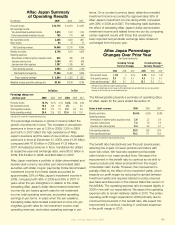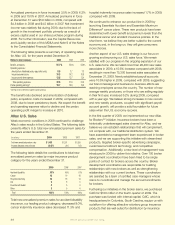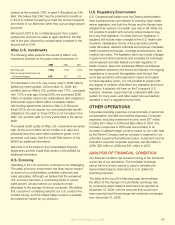Aflac 2009 Annual Report Download - page 29
Download and view the complete annual report
Please find page 29 of the 2009 Aflac annual report below. You can navigate through the pages in the report by either clicking on the pages listed below, or by using the keyword search tool below to find specific information within the annual report.
Company of Columbus (Aac), which operates in the United
States (Aac U.S.) and as a branch in Japan (Aac Japan).
Additionally, Aac U.S. markets and administers group
products through Continental American Insurance Company
(CAIC). Most of Aac’s policies are individually underwritten
and marketed through independent agents. Our insurance
operations in the United States and our branch in Japan
service the two markets for our insurance business.
During the fourth quarter of 2009, the Parent Company
closed its $100 million purchase of Continental American
Insurance Group, Inc. (CAIG), which includes its wholly
owned subsidiary CAIC. Subsequent to the closing, CAIG
merged into Continental American Group, LLC, a limited
liability company wholly owned by CAIC. As a result of
the merger, CAIC became directly wholly owned by the
Parent Company. CAIC is headquartered in Columbia,
South Carolina, and equips Aac U.S. with a platform for
offering attractive voluntary group insurance products that
are well-suited for distribution by insurance brokers at the
worksite. The purchase business combination resulted in
the recognition of $97 million of net assets at fair value. An
immaterial amount of intangible assets, including goodwill,
was recognized as part of the business combination.
2009 PERFORMANCE HIGHLIGHTS
Results for 2009 beneted from the stronger yen. Total
revenues rose 10.3% to $18.3 billion, compared with $16.6
billion a year ago. Net earnings were $1.5 billion, or $3.19
per diluted share, compared with $1.3 billion, or $2.62 per
share, in 2008.
We experienced net realized investment losses of $1.2
billion in 2009, which included the recognition of other-than-
temporary impairments of $1.4 billion. During 2009, we had
a $1.0 billion decrease in gross unrealized losses on our
available-for-sale debt and perpetual securities due to the
recognition of impairment losses and improved fair values
for many categories of investment securities.
In 2009, we borrowed a total of $1.4 billion, consisting
of $1.3 billion in dollar-denominated senior notes raised
through U.S. public debt offerings and loans totaling ¥15
billion. We used $450 million of this capital to redeem
our senior notes that were due in 2009, and we plan to
use some of this capital to redeem our yen-denominated
Samurai notes due July 2010, a liability of $428 million using
the December 31, 2009 exchange rate. We have suspended
stock repurchase activity in the open market. The raising
of capital and suspension of stock repurchase activity have
had a favorable impact on our capital position.
CRITICAL ACCOUNTING ESTIMATES
We prepare our nancial statements in accordance with
U.S. generally accepted accounting principles (GAAP).
These principles are established primarily by the Financial
Accounting Standards Board (FASB). References to
GAAP issued by the FASB in this MD&A are to the FASB
Accounting Standards CodicationTM (ASC). The preparation
of nancial statements in conformity with GAAP requires us
to make estimates based on currently available information
when recording transactions resulting from business
operations. The estimates that we deem to be most critical
to an understanding of Aac’s results of operations and
nancial condition are those related to the valuation of
investments, deferred policy acquisition costs, liabilities for
future policy benets and unpaid policy claims, and income
taxes. The preparation and evaluation of these critical
accounting estimates involve the use of various assumptions
developed from management’s analyses and judgments.
The application of these critical accounting estimates
determines the values at which 94% of our assets and 88%
of our liabilities are reported as of December 31, 2009, and
thus has a direct effect on net earnings and shareholders’
equity. Subsequent experience or use of other assumptions
could produce signicantly different results.
Investments
Aac’s investments in debt, perpetual and equity securities
include both publicly issued and privately issued securities.
For privately issued securities, we receive pricing data from
external sources that take into account each security’s
credit quality and liquidity characteristics. We also routinely
review our investments that have experienced declines in
fair value to determine if the decline is other than temporary.
These reviews are performed with consideration of the
facts and circumstances of an issuer in accordance with
applicable accounting guidance. The identication of
distressed investments, the determination of fair value if not
publicly traded, and the assessment of whether a decline
is other than temporary involve signicant management
judgment and require evaluation of factors, including but not
limited to:
• issuer nancial condition, including protability and cash
ows
• credit status of the issuer
• the issuer’s specic and general competitive environment
• published reports
• general economic environment
• regulatory, legislative and political environment
• the severity of the decline in fair value
• the length of time the fair value is below cost
• our intent, need, or both to sell the security prior to
its anticipated recovery in value
• other factors as may become available from time
to time
Aflac Annual Report for 2009 25




